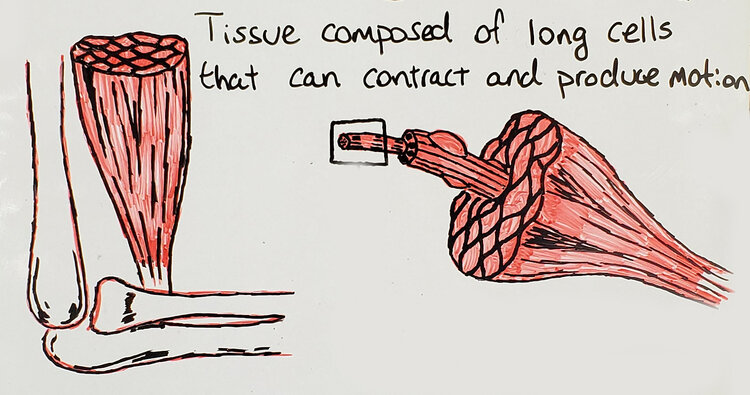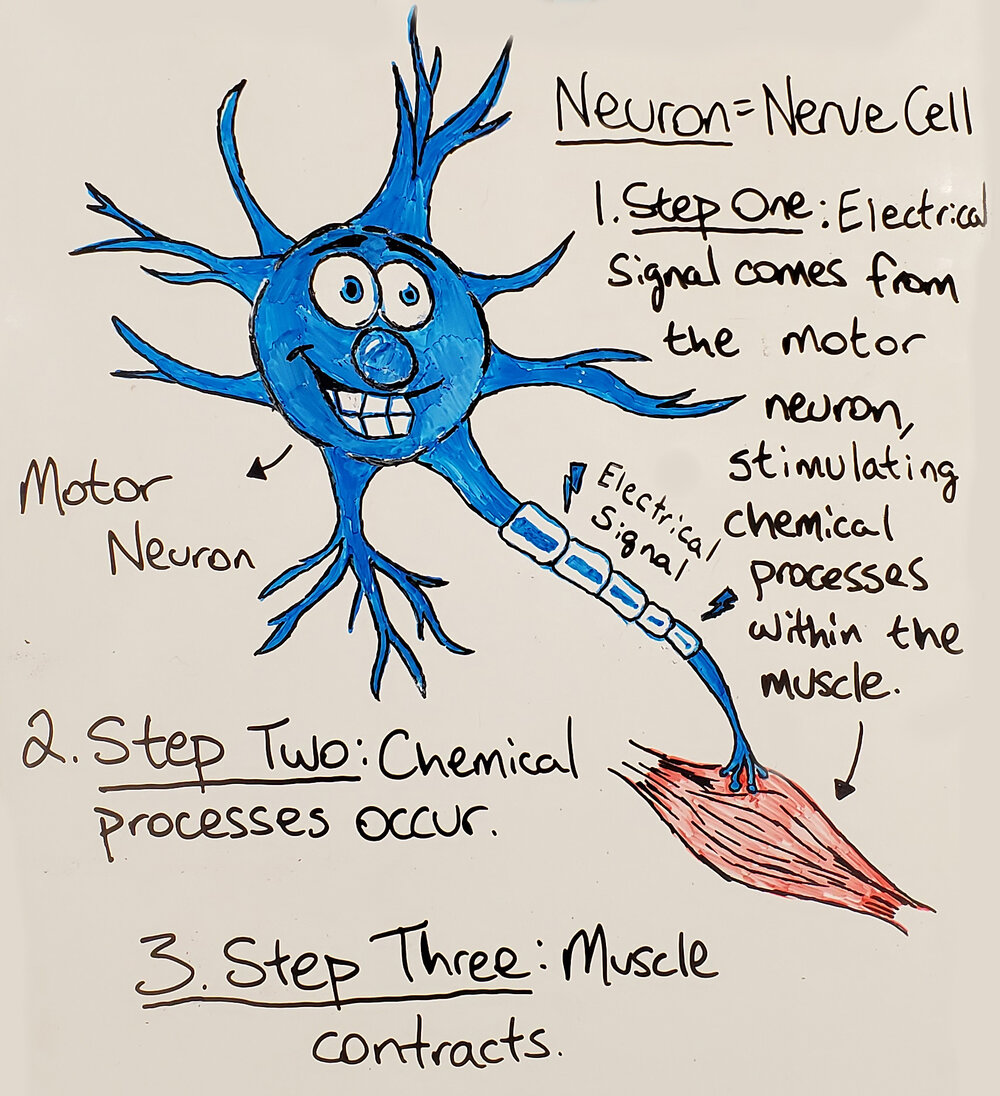
I want to introduce you to some of the reasons we strength train. Specifically, we will discuss the basics of the three body components we are having an effect on when we strength train. These are our joints, muscles, and neurons. This blog is going to be a brief analysis of these bits of our anatomy. Let's get started with joints.
Joints
Joints are junctions of bones. Most joints are named by the intersection of the two bones that make up the joint. For example, the elbow is made up of two joints that connects three bones: the humeroradial and the humeroulnar joint.
There are joints that allow no movement, some movement, and then a lot of movement. Joints like the shoulder and hip offer maximum movement. Joints like the knee offer mostly single direction movement. You even have joints that connect the individual bones of your skull together (they don't move much FYI).
The hip and shoulder joint are ball and socket joints. That means that one the surface of one end of the joint is a ball (duh) and the other is a concave surface that allows the ball to articulate. Joints are grouped by the type of joint they are, like ball and socket as well as hinge. They are also grouped by how many directions they move.
We’ve all heard of axes in math class. There are joints that are uniaxial and allow movement on one axis, like the elbow. Biaxial joints, which, you guessed it, allow motion in two, like the wrist or foot. And multiaxial joints that allow movement in a whole gaggle of axes. The hip and shoulder are examples of these types of joints. The hip and shoulder joint are the layman names for these joints. Truly, the shoulder is made of a whole bunch of joints, not just the ball and socket one we have all come to know and love. You have the acromioclavicular joint, the sternoclavicular joint, and the glenohumeral joint. (But you don't have to worry about those.)
Muscles
Unfortunately, joints can't move on there own. That’s where muscles come in. A muscle is this crazy tissue that crosses joints. Based on the direction and attachment locations, it will produce the movement that the joint allows (or sometimes doesn’t, if you have move like sh*t).

The reason a muscle can do this is because it is made up of contractile tissue. What this means is that it can get shorter or longer because it has mechanisms inside that can slide over each other.
If you can’t picture this, take your hands and interlace your fingers. Bring your hands close so that they are interlaced nice and tight. Then, bring them apart so that the sides of your finger tips are touching. If each of your fingers is a muscle filament, then them being interlaced is how the filaments within a muscle slide along one another.
This is called the Sliding Filament Theory and if you tell people about it at parties they instantly fall asleep.
When a muscle is producing force (i.e opening a door, kicking a soccer ball, telling a girl you're trying to impress which way the beach is), those filaments are stacking on top of each other, just like your interlaced fingers, and moving the two ends of the joint it’s attached to closer together. The biceps brachii (beach direction muscle) attaches at the top of the upper arm and connects to the upper part of the bone below the elbow. Flexing the bicep causes the hinge-like elbow joint to close like the hinge of a door would.
If these filaments can slide on top of one another, is it possible for them to get stuck? Yes, presumably, it is. That is where some of your immobility and inflexibility comes from. I’m oversimplifying the equation. There is connective tissue and nerve cells that are also causing immobility. However, some of it does come from your filaments being “stuck” in an un-slid position.
Neurons
Savvy kinesiology PhD, please do not mind the simplification of what I am about to say. We are about to talk about nerves, of which I know little, but I know enough to tell you a bit about how they interact with the muscles to get you to move. Nerve cells transmit electrical signals that tell the body what to do. Whether that is to beat your heart, tell you to move your hand from a hot stove, or to text your boyfriend and tell him it’s over, Brian.

Neurons are pretty ubiquitous. When it comes to nerves, muscles get special motor neurons that come from your spinal cord. The cool thing about motor neurons is although each muscle fiber only gets one neuron, motor neurons have tentacles (they're not called that) that can be attached to hundreds or even thousands of muscle fibers. I could’ve made an analogy to polygamy right there, but I didn't and you're welcome.
Polygamous motor neurons are not always the solution in your body. In big muscles, like your quadriceps, a motor neuron that activates a whole gang of muscle fibers is great. The quads extend the knee. This movement is simple, and doesn't need much detailed control. But for finer movements, like moving your index finger 3.29 degrees in any direction, motor neurons may only activate one or two muscle fibers at a time. If you’re trying to get a quick peek at the cutie from across the library, the small movements of your eye need a more monogamous approach in the motor neuron to muscle fiber marriage (this analogy is terrible, I'm sorry).
Motor neurons tell your muscles move and muscles make your joints move. Therefore, you move. When motor neurons need you to increase how much you are moving or increase the force at which you are moving, many of them band together to produce the force necessary to do the required action. You can imagine that the harder you twist the lid on the pickle jar, the more of these neurons are firing to activate more muscles that will give you more strength. Even more neurons and muscle fibers are required to Back Squat 500lbs (unless you're that bad at taking pickle jar lids off).
Apart from motor neurons, there are sensory neurons that also play a role in your muscles being able to do things. Sensory neurons might do things like tell you if a feather just brushed up against your forearm, if you have a knife through your calf, or to tell the brain how stretched out they feel. The last one is important (not to say the first two weren’t) because your crappy mobility might be caused by sensory neurons sensing instability and tightness. These sensations may stop you from moving through a full range of motion during a lift or a stretch. This type of immobility isn't about the length of the actual muscle. It is more that the sensory nerve thinks that it shouldn’t lengthen any more or you’ll die (more likely it is just thinking you’ll sprain the muscle it's attached to). One thing mobility training can do is provide our muscles with the peace and quiet from some of these sensory nerves and allow them to lengthen a little more than previously thought.
This was a gross oversimplification of neurological principles by a guy who only has his Bachelor’s in a semi-related field. So, take what I said with a grain of salt. However, if you’re wondering what you are training when you train, I hope now you feel a little closer to that answer. And if you feel further from the answer, I wouldn't read any more of my blogs because they're just as bad.